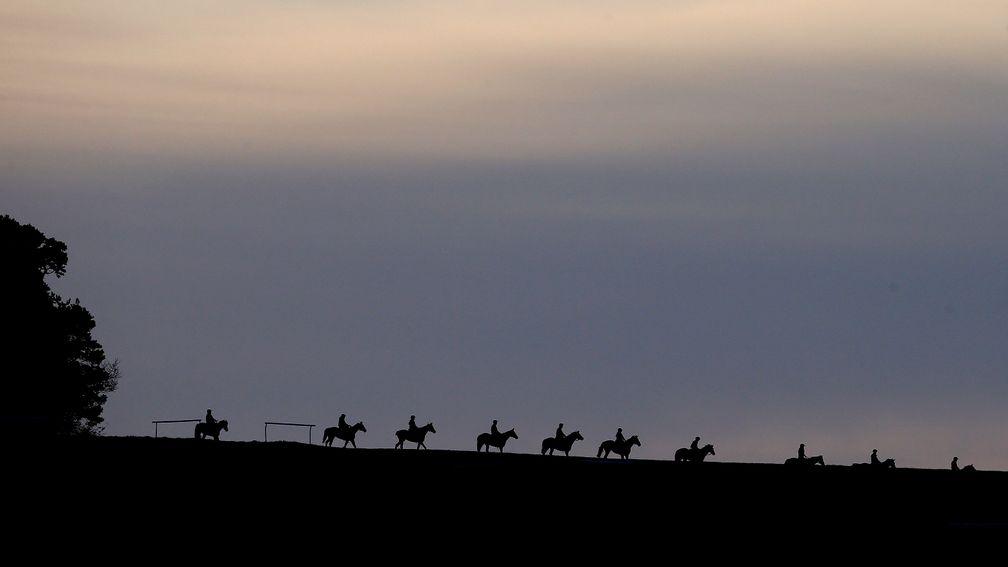Slowboats and speedfreaks: how different is it training a sprinter and a chaser?
Steve Dennis examines the contrasting methods of handling horses

First, catch your horse. The art of training is neither plain nor easy, especially considering the wide variety of horses out there, from the fast-twitch five-furlong specialist to the sturdy, steady long-distance chaser. And then, once you've caught your horse, what's the method for bringing it to the boil?
The broad brush of layman's terms paints a picture of morning exercise as a group of horses starting at the bottom of the gallop and running to the top. It's true; they do. But does a Battaash do the same work as a Sizing John? Or is it different strokes for different yokes?
One trainer with the experience to answer this question is Lydia Richards, whose yard in Funtington, West Sussex has been home to that aforementioned wide variety of horses over the years, from Glorious Goodwood 5f winner Double M to Racing Post Chase runner-up Eau De Cologne.
"All trainers do things slightly differently, we all have our own ideas and methods," she says. "But there are generalisations to be drawn: sprinters and staying chasers look different, sprinters are usually short-coupled, carry a lot of condition, have a big backside and strength through the shoulders.
"Staying chasers tend to be much more angular – if you put a Nunthorpe winner in the same field as a Cheltenham Gold Cup winner you could easily distinguish between them."
So catch one of them; it's probably easier to catch the less explosive staying chaser. He's had a summer break, and tends to the fat rather than the fit. Now, how do you do what you do to him?

"My staying chasers do the same amount of roadwork as my sprinters – they all do around four weeks on the roads," says Richards.
"The difference comes when they begin cantering and galloping. My staying chaser will canter, canter, canter, starting with one trip up the gallop before graduating to two and then three trips daily over a period of around two and a half months.
"For the last two weeks of that they'd be doing fast work, galloping, they're really fit by that stage."
Other trainers might not let their sprinters spend as long on the roads as Cool Hand Luke, but Richards is an advocate of easing them back into full work rather than pushing them. Sprinters can run more often than other varieties of thoroughbred, they're the frequent flyers of the racing world, they take fewer breaks, they put in the graft, so any chance to keep them out of top gear is gratefully received.
Richards' all-weather gallop is a searching test, seven furlongs winding picturesquely up the side of the South Downs with the nasty surprise of a steeper gradient halfway up. This allows her to get horses fit through repetitive cantering, whereas the flatter the gallop the more actual galloping would be required, which therefore means harder work for the horses concerned.
The staying chaser is thus brought to a physical peak by an attritional regime, whereas his sprinting stablemate clocks on for a markedly different work schedule. Built for speed, his exercise is designed to enhance his natural talents. Catch him if you can.
It's apparently easier to get a sprinter fit than a staying chaser, largely because their more muscular physique lends itself to conditioning. Richards allows that a sprinter wouldn't need to be as fit as a three-mile chaser anyway, which doesn't mean that they're all slackers, rather that the searching test of three miles in the mud makes greater demands on a horse than the relatively more forgiving minute on fast ground over five furlongs.
Richards' sprinters canter too, but this is where their training regime diverges from their long-haul stablemates. They go half as far but twice as fast.
"I only use the top three furlongs of the gallop for sprinters, they don't go further than that. It's very much boom, they're gone, see you later, because that's what they do, that's what you want them to do when they're racing, so if you try to restrain them at home you're sending them the wrong messages.
"They can be a bit of a law unto themselves, they're highly strung, they're explosive, you can wind them up too far. So I work them and then turn them out into a paddock for the rest of the day, keeps their minds right."
Now and then you hear the remark that some top-notch ten-furlong horse is so quick that he could drop down and win the July Cup. Not many do, though. Richards shakes her head, reckoning that given the nature of her gallop it would be easier to stretch a sprinter out and make him a miler rather than going the other way, easier to add staying power than subtract it. Other trainers, with different gallops topography, might tell another story.
"Sprinters are easier to train, probably," adds Richards. "They take less time, they need less micro-managing. But you can't beat the sight of a good staying chaser, can you? So tough, so brave, so exciting."
So which, given the choice, is her favourite raw ingredient in the recipe for success? "I don't have a preference, really – either will do very nicely, as long as it wins races."
If you liked this you should read others in our Racing Revealed series:
They've all lost out by a whisker but why do so few jockeys have beards?
How true is the famous saying 'you never meet a poor bookmaker'?
The art, rules and rudeness of naming racehorses
So, how much does a jockey really earn?
So, can horses really suffer from hay fever?
Published on 5 October 2017inFeatures
Last updated 19:25, 5 October 2017
- Government says it is working 'at pace' to have white paper measures in force by the summer
- 'The only thing you can do is lie fallow and regroup' - Meades to return with scaled-back operation following blank period
- The Gambling Commission has launched its new corporate strategy - but what are the key points?
- 'It was tragic it happened to Paddy but it was a good thing for the jockeys who followed - good came out of bad'
- Acquisitions, exits and retail resilience - what we learned from Flutter and 888's results
- Government says it is working 'at pace' to have white paper measures in force by the summer
- 'The only thing you can do is lie fallow and regroup' - Meades to return with scaled-back operation following blank period
- The Gambling Commission has launched its new corporate strategy - but what are the key points?
- 'It was tragic it happened to Paddy but it was a good thing for the jockeys who followed - good came out of bad'
- Acquisitions, exits and retail resilience - what we learned from Flutter and 888's results